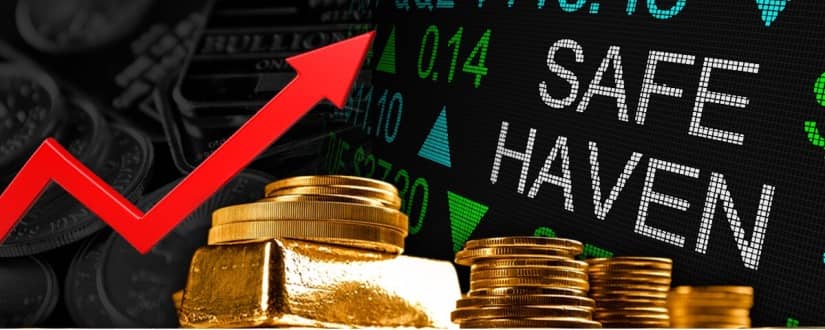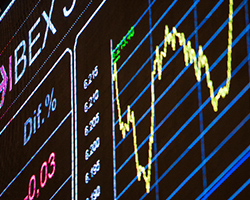Understanding Safe Haven Assets: What & Why?

Imagine that you used all your savings to buy shares in a promising IT company. The company has released new products, reported good revenues, and the share price has risen sharply. You rejoice in the earnings. But then the CEO of the startup makes an unfortunate joke on Twitter, it causes a scandal and the stock plummeted in price, and you are in the red. Stressful situation, right? To worry less, you shouldn't build a portfolio of only risky assets, such as startup stocks. You need to invest in so-called safe haven assets as well. Let`s find out what these are and how to use them properly.
What are Safe Haven Assets?
If we give a professional definition, then assets with zero or inverse dependence on market conditions are called safe haven assets. In simple terms, these are securities (and other financial market instruments) that react minimally to stock fluctuations. And some of them even rise in value when market indices go down. Yet one cannot make a quick and big gains on such assets: they bring stable but small income. This is their other peculiarity.
How Safe Haven Assets Work
In a well-balanced portfolio, safe haven assets must be present regardless of the strategy chosen by the investor. The only question is the share they should occupy. First, the success of the portfolio directly depends on it. The logic behind it is simple. The more safe haven assets, the more stable the portfolio, but one should not count on a high return. And vice versa: the lower the percentage of safe haven assets is, the more you can earn, but the risk of losing capital increases as well.
Each investor makes his own decision. Nonetheless, it is safe to assume that a portfolio with 70-80% of protective assets - bonds, and short-term market instruments - is primarily aimed at preserving capital. There are also more radical approaches. In Morgan Stanley's Global Balanced Defensive strategy, the bond portion is 73.1% and another 21.3% are Cash Equivalents. Only 5.6% is left for the risk part.
If your portfolio is for decades to come, there is no point in artificially inflating the proportion of safe haven assets. For example, Bill Bernstein's No Brainer Portfolio has only 25% bonds.
With the right mix of other investment tools, even a portfolio with a significant amount of safe haven assets can yield a good return.
One more important condition. For safe haven assets to fully perform their functions, they must be selected according to the specifics of other assets in the portfolio. Different instruments, for example, shares of developed markets and shares of emerging markets, have different risks. And in order to minimize them, the composition of protective assets should be adequate to the risks.
If in doubt, an advising service can help. The smart algorithms will individually select a balanced portfolio, taking into account the level of risk that is comfortable for you. And it will automatically rebalance it, maintaining a balance of high-yielding and safe haven assets to achieve the financial objective sooner. And you will save capital and nerves.
Let us now consider different types of safe haven assets for you to choose from.
Bonds
Short bonds (up to 3 years) are a priority. Long bonds, as a rule, are more sensitive to any changes in the market. It is advisable to tie duration to your investment horizon. Floating-rate securities are generally more immune to changes in Central Bank and Federal Reserve policies. Eurobonds are denominated in a hard currency and often increase coupon yields in a crisis. However, volatility prevents them from being treated as safe haven assets. The credit rating of bond issuers should not be lower than BB-. The debt load should not be high. Check the issuers' financial statements.
Low-liquidity bonds, including municipal bonds, become riskier during the crisis than usual. Only securities of wealthy entities can be held in a portfolio. The same applies to most corporate bonds. The issuer must either have foreign exchange earnings or a stable cash flow.
Securities with the highest degree of protection are called risk-free. This usually includes U.S. Treasury bonds. This is the most popular and liquid safe haven asset in the world. Despite the enormous national debt, which has exceeded $21 trillion, investors continue to invest in Treasuries in any negative market conditions. They are guaranteed by the status of the dollar as the world currency, the power of the largest economy on the planet, and the high level of confidence in the U.S. government obligations. Investors take into account the fact that in times of global turmoil the U.S. economy looks stronger than others, even if the crisis itself began in the U.S. Additional value is added to bonds because of their rising yields. The downside is limited availability to unqualified investors.
Stocks
Safe haven stocks generally rise less in a bullish market and fall less in a bearish market, and their main attribute is stability. Such stocks tend not to interest speculators. Priority is given to issuers whose products are in constant demand and are not subject to cyclicality. If a company's business is strategically important for the state economy - even better. Good dividend history will be a benefit.
There are contradictory views on the safe haven capabilities of consumer sector securities. Some experts believe that constant demand for essential products will guarantee a stable cash flow. Others refer to statistics, where retailers' performance is deteriorating following the market. This is contributed to by a decline in consumer demand even in the discount segment.
Second- and third-tier stocks, especially those with high debt loads, are the least predictable in times of crisis. Small-capitalization companies are not included in the first-priority state programs of business support. During a crisis, they typically experience higher drawdowns than first-tier stocks.
Holding large long positions in stocks during a crisis is not a good decision. The exceptions are the highest quality issuers, with low debt and stable revenue streams, or better yet, with a cash cushion. Long positions in quality stocks can be hedged with short positions in stocks from other industries or in index futures.
Currency
Cash in foreign currency is a reliable safe haven asset on any market. Preference is given to the U.S. dollar, which is always in demand in an unfavorable economic situation. Less popular are Euro, Japanese Yen, and Swiss Franc.
In recent years, the Swiss franc has demonstrated its resilience to any market fluctuations. Against the euro, there was steady growth, so the Central Bank, guided by the interests of Swiss exporters, set the limits of the franc fluctuation in the range of 1.2-1.24 francs per euro. The strengthening of the currency is due to the strong Swiss banking system and the highly developed economy of the country: Switzerland is one of the world's leading producers of medicines, machinery, and building materials.
However, it is recommended to keep funds in different currencies, e.g. 60% in US Dollars, 20% in Swiss Francs, and 20% in Euros. Also, you should keep some funds in your local currency so if the need arises to use your savings, you need it in order not to lose funds on currency conversion.
Many people, when an economic downturn hits, prefer not to hoard foreign currency, but rather to spend finances by buying real estate, cars, and machinery. The reason is that before the national currency devalues, even more, it is better to spend it on something useful. However, this buying frenzy leads to a shortage of cash supply.
Having capital in currency is the easiest way to avoid losses during an economic crisis. Next, we will talk about another type of investment, around which there is a lot of controversies, yet most Russians prefer it, both during the recession and in a stable economic situation.
The US dollar
The US dollar is a traditional defensive tool in the world markets. In periods of deteriorating market or geopolitical situation, the dollar appreciates against other currencies as investors flee from risky assets to safe haven ones.
An additional plus for medium-term investments in the dollar is the fact that the Fed has begun winding down monetary stimulus before other major central banks. The tightening of monetary policy is a major factor in the appreciation of any currency.
Euro
Euro is the world's second most traded currency after the U.S. dollar. However, the ECB has so far lagged behind the Fed in terms of monetary policy tightening amid the weaker performance of the European economy. This primarily concerns the likely start of interest rate hikes in the EU.
Considering that the current geopolitical conflict is escalating close to the European borders, this brings additional risks to investing in the euro, which has been under pressure in recent sessions.
Swiss franc
The Swiss franc has historically been one of the world's most stable currencies due to the strength of the Swiss economy, which is based on highly specialized labor and ideal conditions for businesses of all sizes. In addition, as the world's largest processor of gold and the de facto banking and financial capital of Europe, the country has earned a reputation as one of the most reliable financial and economic systems in the world. The long-term political stability of this state and its foreign policy neutrality plays an important role.
Thanks to this combination of characteristics of the country the Swiss franc is one of the major safe haven currencies along with the dollar. However, due to the relatively low liquidity of the Swiss franc in the market, investments in it make sense mainly in the long term for conservative preservation of capital.
Commodity currencies
Geopolitical escalation provokes active appreciation in commodities, which are already near multi-year or historic peaks. This contributes to the strengthening of commodity currencies, which circulate in the countries whose economies are heavily dependent on the export of commodities (Canadian and Australian dollars).
Long-term investments in commodity currencies have higher risks, mainly connected with the dynamics of commodity markets.
Real Estate
If we recall the crises of 2008 and 2014, real estate prices fell. This is related, of course, to falling demand. In both cases, the fall in prices was also observed in the 2 years after the recession. And only by 2017, when the purchasing power of the population recovered, did demand begin to increase. And this applies mainly to properties located in major metropolitan areas.
Investment in real estate is a long-term investment. Buying homes to rent during the recession may not be effective, because the drop in purchasing power of the population will drag down the cost of renting. At the same time, utilities are likely to remain the same or rise in price.
But to buy a property at the peak of falling prices, while having the means to survive and receive at least minimal income from other investments may seem like a good idea. Provided that you just bought the property, not making any additional investment in it until the country is completely out of the crisis. Then the value of the home will increase, and you'll be able to generate income from the sale or operation of the property.
How to Protect a Portfolio on the Eve of the Crisis
There can't be "eternal" recommendations to choose safe haven assets. They can behave differently in different situations, even if the general signs of the crisis are the same. Quotes for assets are influenced by a multitude of factors, so every time you need to analyze the current situation anew. For example, the "safety mix" of bonds, gold, and the Japanese yen that worked during the 2008 crisis may not work in the future. For example, bonds will be less beneficial because of higher interest rates, the yen will not rise because the BoJ decided to keep pumping funds into the economy. This does not mean that investors should not focus on traditional safe haven assets. There is no 100% guarantee that each instrument will be effective, but portfolio risk will be reduced.
Protective assets should be sought not on the eve of a crisis, especially not in the midst of it. They should always be in the portfolio. But as the crisis worsens, it's wise to rebalance in order to reduce dependence on market conditions. It is quite normal that along with protection, an investor will receive a reduction in returns.
Conclusion
The portfolio should be balanced in such a way that it will not suffer if the crisis does not happen. It is a mistake to completely withdraw from high-priced assets at the first sign of stagnation. The goal is to shift your focus toward safe haven assets. As the prognosis of a crisis comes true, strengthen positions in conservative instruments and hedge risks in successful ones. The ideal is a universal long-term strategy that is minimally dependent on market conditions. In particular, systematic investment of a portion of income in index funds, dividend stocks, and bonds provides an advantage over the long term. It is also important to follow the rules of currency and industry diversification. This protects against any changes.









